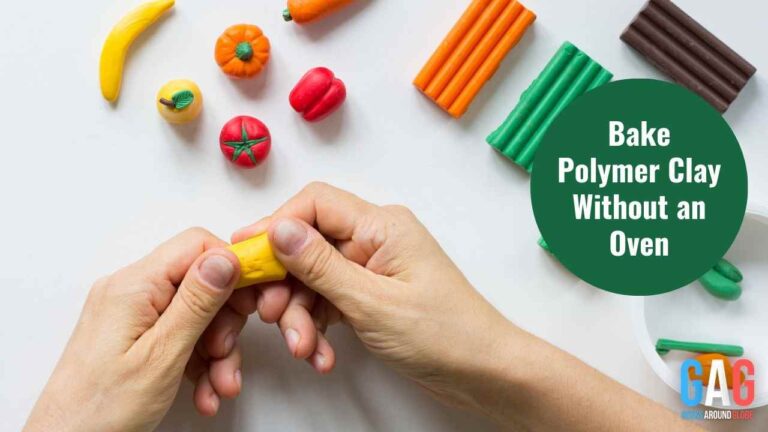Polymer clay is a versatile modeling clay. It’s frequently and widely used in crafts and artistic projects. A soft and malleable clay that comes in a range of colors.
As Crafters, Polymer clay enthusiasts should prioritize safety when working with this versatile modeling clay. This comprehensive guide is for crafting enthusiasts to examine and learn about possible hazards and how to be safe when working with Polymer clay.
What Is Polymer Clay Made out Of?
Manufacturers make polymer clay by combining PVC resins, flexible plasticizers, texture-enhancing fillers, and coloring agents.It has the attributes required for crafting thanks to these components. It does not dry when exposed to air. Crafters, shape and solidify the clay through baking, creating durable artwork.
Generally, Polymer clay is considered a risk-free material. However, improper handling of it can turn anything into a potential risk. Keep reading to know about the precautions that you should take.
Potential Hazards of Polymer Clay
When we are not aware of the possibilities of and how to handle them, situation can be hazardous. Let’s find out the potential possibilities of risk.
Chemical risks associated with polymer clay
Improper handling of polymer clay could pose a lot of health risks. Manufacturers use plasticizers like phthalates to make the clay flexible. However, they are linked to several health risks, including reproductive and birth disorders. It’s vital to understand these risks and adopt the appropriate safety measures.
Physical hazards posed by polymer clay
You definitely wouldn’t want to burn yourself while making a piece of art. Working with heated clay can easily cause burns. Watch out for those burns.
On the other hand, health issues might also occur from inhaling or inhaling clay particles. To reduce these dangers, people should use proper handling methods and safety measures. Make sure to use masks and safety glasses to avoid aggravating asthma symptoms and eye discomfort.
Environmental considerations for working with polymer clay

When using polymer clay, proper ventilation is essential to prevent extended exposure to toxic vapors. Therefore, working in an environment with excellent ventilation helps to keep the air quality clean.
We should always make sure we don’t pollute the environment as well. So,it’s important to practice proper garbage disposal to minimize environmental pollution.
Fire Hazards
Additionally, improper backing of polymer clay can cause a fire risk. Hydrochloric acid and other poisonous gasses may be released if the clay is overheated or burns.
It’s important to follow the package’s directions properly.
Health and Safety Considerations
Risks to pregnant women and children

Importantly, Pregnant women and small children should take extra care since they may be more vulnerable to the risks of polymer clay. So, Exposure to clay fumes should be avoided by pregnant women.
small children should be watched to prevent them from swallowing tiny objects made of clay. To prevent the clay from being consumed, young children under the age of six should be constantly watched.
Allergic Reactions and Sensitivities.
Polymer clay is Generally harmless. However, some people could react negatively or be sensitive to particular elements. Some people may experience skin reactions, similar to contact dermatitis.
Accordingly,You can look further into this matter in forums like Reddit.com and wetcanvas.com, where people state these matters.
There are two different sorts of irritations that may develop.
Cutaneous (skin) Irritation
1) Redness and swelling
2)Swelling, inflammation, and discomfort similar to those experienced after a bee sting (itching, burning, stinging? )
3) Breathing problems or asthma with redness and itching
4) Anaphylaxis (systemic shock similar to that experienced by those who are allergic to peanuts or bee stings) with redness and itching.
Contact Allergy or Sensitivity Reaction
This allergy has a similar reaction to the previous one. However, The reaction is frequently considerably quicker and more intense. It develops gradually over time.
If you have a history of allergies or sensitivity to a variety of other substances, be extra cautious. It is important that the people who experience reactions should closely monitor their welts and rashes and contact a doctor right away.
In order to reduce the danger of allergic responses, identify common allergens in polymer clay and implementing the appropriate safety measures. You should wear gloves and maintain excellent hand hygiene. Using barrier creams is another option to avoid skin contact with polymer clay.
Toxic Fumes:
When polymer clay is heated too much, harmful fumes might be released. Hydrochloric acid gas is created when polymer clay is burned at temperatures higher than 350 degrees Fahrenheit. This gas can irritate mucous membranes and be uncomfortable for the eyes, nose, and throat. It’s crucial to have enough ventilation and to refrain from breathing in too much fumes.
If you are a polymer clay enthusiast don’t worry about the risks. It’s very easy to tackle those with proper safety guidelines. Keep reading to know about how to protect yourself from possible risks.
Polymer Clay Safety Guidelines.
Personal protective equipment (PPE)
It is always the best practice to use personal protective equipment when using polymer clay. Wear protective gloves and glasses. This would help you prevent skin rashes and eye damage.
Safe handling and workspace setup

Make sure to keep your workstation tidy and organized. Refrain from eating while working with clay to avoid ingesting clay particles. To avoid cross-contamination, have certain equipment and work areas just for polymer clay.
Proper ventilation and air filtration
Always work in a well-ventilated space or use fans or air purifiers. This will enhance air circulation and eliminate odors or dust particles.
Minimizing exposure and risks
Remember to Use safe handling methods. Don’t forget to wash your hands after handling clay. Most importantly be cautious while cutting or carving as you might cut yourself. You can reduce clay dust inhalation by wet Sanding or using face marks.
Minimizing Health Risks
Follow safe baking practices for polymer clay, to reduce the risk of health issues. It is very important to follow safe baking techniques with appropriate temperatures. This would reduce the production of toxic gases. Additionally, be mindful of skin irritation and allergies. It is better to discontinue use if any adverse reactions occur.
First Aid and Emergency Procedures
Always prepare for accidents and injuries. If you get burnt, rinse the area with cold water. If necessary, do not hesitate to get medical assistance. You should carefully clean and treat the wounds appropriately. For severe symptoms or allergic reactions, seek quick medical attention.
Conclusion
It is indeed fun to work with polymer clay, but you should always put your safety first. Make sure that you take proper safety precautions. This would help you to minimize risks and work with complete confidence while enjoying your creativity. Ensure your well-being by educating yourself and using extra resources for clarification. Put your safety first then enjoy your journey with polymer clay.
FAQ
Polymer clay is generally safe for humans to use. However, you should take precautions to minimize risks.
When working with polymer clay, it’s important to be cautious of potential risks. They could be burns from hot clay, inhalation of clay particles, exposure to toxic fumes and very rarely skin irritation could also occur. Make sure to have proper ventilation, personal protective equipment, and safe handling techniques.
Polymer clay is safe after baking. Make sure that it has been properly cured according to the manufacturer’s instructions.
Yes, they are safe to wear when made and baked correctly







